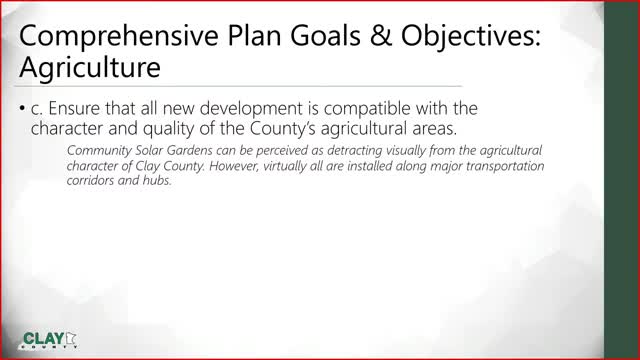Solar project sparks debate over land use and aesthetics
August 21, 2024 | Clay County, Minnesota
This article was created by AI summarizing key points discussed. AI makes mistakes, so for full details and context, please refer to the video of the full meeting. Please report any errors so we can fix them. Report an error »

In a recent government meeting, discussions centered around the approval of a solar energy project in Clay County, highlighting both the potential benefits and concerns associated with solar development in rural landscapes. The project, which would occupy approximately 28.8 acres of agricultural land, is part of a broader initiative to promote renewable energy while maintaining the county's agricultural character.
Officials noted that while some residents view solar installations as visually detracting from the rural aesthetic, others see them as an integral part of the evolving agricultural landscape. The project is strategically located along major transportation corridors, minimizing its impact on more idyllic rural areas. Importantly, the land can be restored to agricultural use after the project's lifespan, which is projected to last 30 to 35 years.
The meeting also addressed environmental considerations, with assurances that the solar development would not encroach on sensitive areas and would not generate significant traffic or noise. In fact, the project is expected to enhance local biodiversity by creating over 28 acres of pollinator and wildlife habitats.
Concerns were raised regarding fire safety and the training required for local fire departments. However, the project developers clarified that no special training would be necessary, as the solar panels do not pose additional toxicity risks and there will be no battery storage on-site.
The developers, represented by Dan Gorman from Enterprise Energy, expressed enthusiasm for the project, emphasizing its compliance with county regulations and its potential to produce approximately 12,500 megawatt hours of energy annually. They also noted that the project would be subject to Minnesota's energy production tax, which could influence future financial models for subscribers.
As the meeting concluded, officials indicated that they would consider extending the timeline for project commencement to accommodate potential supply chain issues, reflecting a willingness to support renewable energy initiatives while balancing community concerns. The public hearing was closed without opposition, paving the way for further discussions on the project’s implementation.
Officials noted that while some residents view solar installations as visually detracting from the rural aesthetic, others see them as an integral part of the evolving agricultural landscape. The project is strategically located along major transportation corridors, minimizing its impact on more idyllic rural areas. Importantly, the land can be restored to agricultural use after the project's lifespan, which is projected to last 30 to 35 years.
The meeting also addressed environmental considerations, with assurances that the solar development would not encroach on sensitive areas and would not generate significant traffic or noise. In fact, the project is expected to enhance local biodiversity by creating over 28 acres of pollinator and wildlife habitats.
Concerns were raised regarding fire safety and the training required for local fire departments. However, the project developers clarified that no special training would be necessary, as the solar panels do not pose additional toxicity risks and there will be no battery storage on-site.
The developers, represented by Dan Gorman from Enterprise Energy, expressed enthusiasm for the project, emphasizing its compliance with county regulations and its potential to produce approximately 12,500 megawatt hours of energy annually. They also noted that the project would be subject to Minnesota's energy production tax, which could influence future financial models for subscribers.
As the meeting concluded, officials indicated that they would consider extending the timeline for project commencement to accommodate potential supply chain issues, reflecting a willingness to support renewable energy initiatives while balancing community concerns. The public hearing was closed without opposition, paving the way for further discussions on the project’s implementation.
View full meeting
This article is based on a recent meeting—watch the full video and explore the complete transcript for deeper insights into the discussion.
View full meeting
